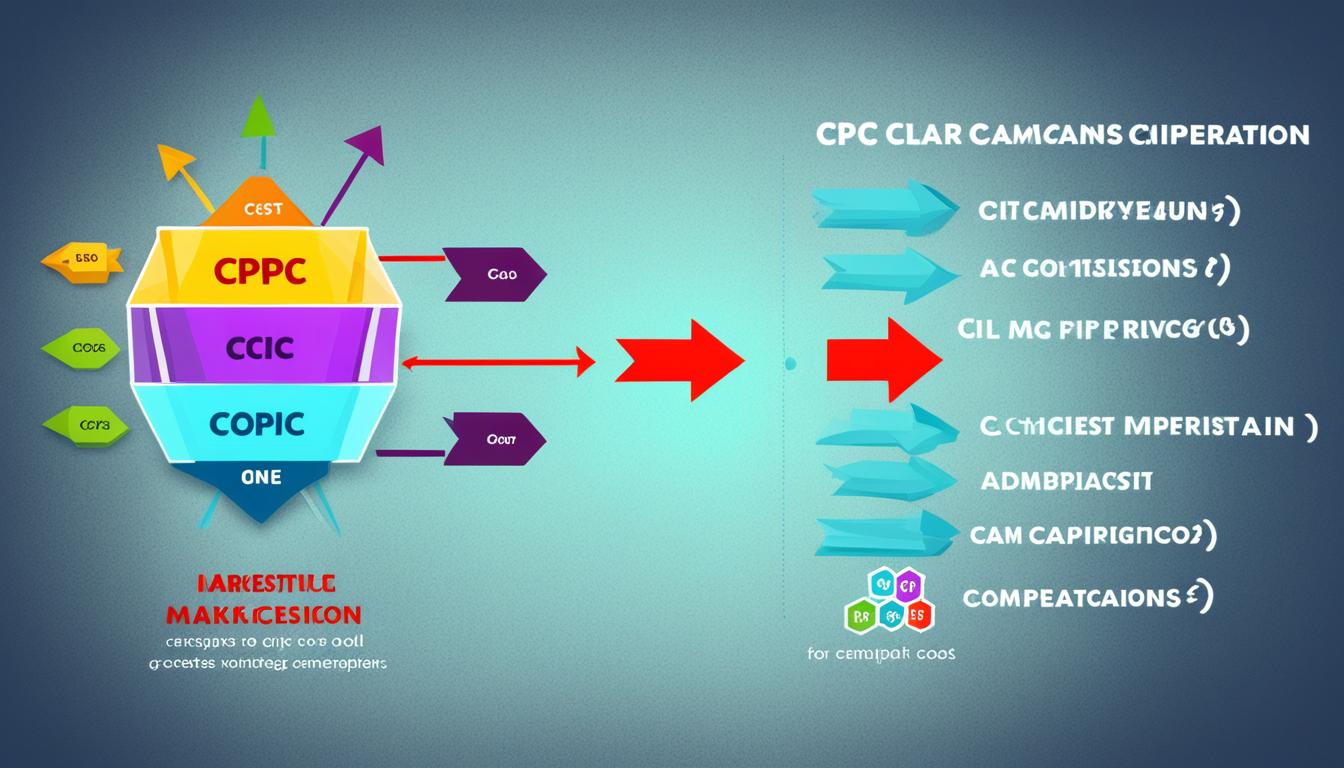Marketing Mix Modeling (MMM) is a way companies figure out how their marketing affects sales. It was introduced by Edmund Jerome McCarthy in 1960. The mix includes product, price, promotion, and place. It’s key to making a product or service succeed. MMM lets companies see what parts of their marketing work best. It helps in deciding where to spend their marketing money and how to make their marketing better by looking at returns on investment (ROI).
Key Takeaways:
- Marketing Mix Modeling is a statistical analysis technique used to measure the effectiveness of marketing activities.
- It helps companies understand the impact of different marketing elements on business metrics and sales.
- By analyzing marketing mix data, businesses can allocate budgets more effectively and optimize marketing strategies.
- Marketing Mix Modeling allows for ROI measurement and data-driven decision-making.
- It helps companies maximize their marketing effectiveness and achieve higher returns on investment.
What is Marketing Mix Modeling?
Marketing Mix Modeling (MMM), or Marketing Mix Analysis, is key for brands wanting to see how their marketing affects business metrics and ROI. It shows how different marketing activities perform and guides strategy optimization for better ROI.
MMM breaks down business metrics into incremental, base, and other drivers. Incremental drivers are results from marketing activities. Base drivers show results without ads. Other drivers help explain base factors.
Through analysis, companies can see how marketing impacts sales and plan their budgets and strategies wisely. This process helps judge campaign effectiveness, guides resource allocation, and improves results.
Key Components of Marketing Mix Modeling
Important parts of Marketing Mix Modeling include:
- Marketing Activities: These are all the brand’s efforts, like ads, promotions, PR, and digital marketing.
- Business Metrics: Key indicators of marketing success, such as sales, market share, and customer numbers.
- Return on Investment (ROI): ROI compares money spent on marketing to the revenue or profit made.
MMM offers brands a full picture of their marketing’s impact on business metrics and ROI. Using MMM insights helps companies make their marketing strategies better, use resources wisely, and improve business performance.
| Benefits of Marketing Mix Modeling | Challenges of Marketing Mix Modeling |
|---|---|
|
|
How Does Marketing Mix Modeling Work?
Marketing Mix Modeling analyzes both internal and external factors to assess their effect on marketing performance. Companies use statistical methods like Multi-Linear Regression to look at how different factors affect sales. This analysis provides data-driven insights for marketing budget planning and optimization.
It considers factors such as baseline sales, marketing tactics, and internal and external influences. Baseline sales derive from brand equity and other non-marketing elements. Marketing tactics include activities like ads and promotional events. External factors cover market conditions that affect consumer behavior, and internal elements involve product placement and pricing strategies.
Understanding these variable relationships helps companies predict marketing activity outcomes. They then optimize marketing investments for the best ROI. This approach aids in crafting and executing marketing strategies effectively.
An example of Marketing Mix Modeling at work is shown in a table:
| Marketing Activity | Impact on Sales |
|---|---|
| TV Advertising | Positive |
| Print Advertising | Neutral |
| Online Campaign | Positive |
| Promotional Events | Positive |
This table highlights how TV ads, online campaigns, and events positively impact sales. Meanwhile, print advertising has a neutral effect. Such insights help marketers decide how to distribute their budget effectively to get the highest ROI.
Through statistical evaluation and analysis of factors, Marketing Mix Modeling offers a structured, data-driven decision-making process. It allows companies to enhance their sales and meet marketing goals.
The Variables in Marketing Mix Modeling
Marketing Mix Modeling looks at different factors that affect how well marketing works. These factors fall into several groups.
Calendar-based Variables
Seasonal trends and major holidays change how people buy things. By studying yearly trends, companies can get how customer habits shift. For example, a clothing store might change its ads based on if people want winter coats or swimsuits.
Media Activities or Marketing Tactics
Media activities cover the ways brands promote their products. This includes ads on TV, in magazines, outdoors, online, through searches, on social media, and earned media. Each way offers a chance to connect with people. Understanding the impact of these methods lets companies spend their money where it works best.
External Factors
External factors are the big picture issues that affect marketing results. This includes the economy, weather, natural disasters, and what competitors do. For instance, a luxury resort’s popularity might change with the economy or travel trends. By looking at these big issues, companies can shift their marketing to seize opportunities or avoid problems.
Internal Factors
Internal factors are within the company and its ways of working. They include changes in how products get to stores, pricing, and selling methods. For example, a company might widen its reach, have sales, or tweak how it sells to make customers happier. Taking these internal factors into account helps companies fine-tune their marketing and do better overall.
The factors in Marketing Mix Modeling are all connected and shed light on how each part affects performance. Studying these factors helps companies make smart decisions, fine-tune their marketing, and get a better return on their investment.
Marketing Mix Modeling Example (In-Depth)
Let’s look at how Marketing Mix Modeling works using an example.
A CPG (Consumer Packaged Goods) brand is planning its budget. It needs to choose between TV ads, direct mail, radio, and print ads. By using a marketing mix model and looking at sales data, the brand can see how each method helps sales. This helps the brand spend its budget smartly, change how much it spends on each method, and get better returns.
To see how different tactics affect sales, we can make a detailed table:
| Tactic | Reach | Sales Impact |
|---|---|---|
| TV Ads | 80% | High |
| Direct Mail | 20% | Medium |
| Radio | 40% | Low |
| Print Advertising | 60% | Medium |
This table shows the reach and sales impact of each tactic. It helps the brand decide where to put its money. By putting more into tactics that reach many people and boost sales, the brand can use its money better.
Marketing Mix Modeling lets brands make choices based on data. This improves their marketing’s impact.
Why Implement Marketing Mix Modeling?
Marketing Mix Modeling offers many benefits for marketers. It assesses marketing effectiveness and measures ROI. It also forecasts future performance and optimizes marketing strategies. With this modeling, companies make decisions based on data, leading to better results. Let’s explore the key advantages more closely.
1. Assess Marketing Effectiveness
Marketing Mix Modeling gives a full view of marketing’s impact on overall effectiveness. It analyzes how each marketing part, like product and price, contributes. This helps companies spot strengths and improve. This insight lets marketers polish their strategies and use resources well.
2. Measure ROI
The main goal of Marketing Mix Modeling is to find out the ROI of marketing efforts. It shows how each marketing activity affects sales or outcomes. Doing this analysis helps companies understand their marketing success. This way, they can wisely allocate budgets to the most effective initiatives.
3. Forecast Future Performance
This modeling predicts future sales or metrics using past data and trends. Companies use statistical analysis to see how changes in marketing or pricing might affect future outcomes. These forecasts are valuable for planning and budgeting.
4. Optimize Marketing Strategies
Marketing Mix Modeling helps find the most impactful marketing activities, channels, or campaigns. Insight from this analysis lets companies use their budgets better and focus on what works best. This optimization improves marketing ROI and overall business performance.
5. Pricing Decisions
This tool is great for making pricing decisions. It looks at how price changes affect consumer behavior and market performance. This helps companies set the best pricing strategies. The right pricing boosts revenue, competitiveness, and profits.
Using Marketing Mix Modeling helps companies make smart, data-driven choices. It boosts marketing effectiveness, accurately measures ROI, and refines marketing strategies. By using this powerful tool, businesses can stay ahead and achieve better outcomes.
Disadvantages of Marketing Mix Modeling
Marketing Mix Modeling is great for boosting marketing plans. But, it does have some downsides. A big hurdle is needing lots of good data. This can be tough for small budget companies or newcomers to large-scale media buying.
Gathering and putting together the necessary data can be tricky and slow. It often asks for strong tools like a marketing data hub. These tools collect, keep, and study the data.
Yet, these hurdles can be beaten by growing data skills within a company. The benefits from Marketing Mix Modeling can really improve marketing tactics. So, it’s definitely worth the effort and spending.
Importance of Developing a Marketing Mix Strategy
A strong marketing mix strategy is key for a product or service to do well in the market. It lets companies see how each part of the marketing mix affects growth. The mix includes product, price, promotion, and place.
Product: The product or service is central to any marketing plan. It’s vital to know what the target audience wants and likes. This means doing market research, checking customer feedback, and keeping up with trends.
Price: How much something costs is very important in marketing. Companies must find a price that fits what people are willing to pay and think the product is worth. It’s crucial to look at costs, competitors, and what customers are willing to spend.
Promotion: Getting the word out effectively is necessary to grab customers’ attention. It’s about choosing the best ways to reach the target audience. This might mean ads, PR, online marketing, and so on. The goal is to match promotion with what the company wants to achieve.
Place: This is about how customers can get the product or service. Companies decide on the best way to do this, based on what’s easiest for their customers. This could mean selling directly, online, through stores, or other ways.
Creating a marketing mix strategy takes a deep look at the market. It involves thinking about prices, where to sell, seasonal changes, and the economy. With this strategy, companies can hit their marketing goals and get a great return on their investment.
A thorough analysis of market performance helps companies know what works best. They can then make smart choices. Looking at how each part of the marketing mix works together lets companies fine-tune their plans, put money into what works, and use their resources well.
Being good at predicting sales and market trends is key. This lets companies make smart choices about new products, where to invest in marketing, and how to use their resources. This keeps the marketing mix agile and ready for market changes.
| Benefits of Developing a Marketing Mix Strategy |
|---|
| 1. Improved decision-making based on data and market insights |
| 2. Better allocation of resources and marketing budget optimization |
| 3. Enhanced customer targeting and brand positioning |
| 4. Anticipation of market trends and opportunities for growth |
| 5. Maximization of ROI through effective marketing strategies |
Building a marketing mix strategy never stops. It needs constant review, changes, and fine-tuning. By focusing on each part of the mix and predicting market changes, businesses can stay ahead. They can grow, reach their goals, and beat the competition.
The Role of Incremental Variables in Marketing Mix Modeling
Understanding incremental variables is key in Marketing Mix Modeling. These variables greatly shape business outcomes and improve marketing strategies. Let’s look at some important incremental variables and how they influence the marketing mix:
Above-the-Line (ATL) Marketing
ATL marketing includes TV, radio, and print ads. These are crucial for building a brand and raising consumer awareness. They reach many people and greatly influence how people see a brand.
By adding ATL marketing to the mix, companies boost their brand’s visibility. They connect with more people this way.
Below-the-Line (BTL) Marketing
BTL marketing targets specific consumer groups through campaigns. Tactics include sales promotions, social media, and direct mail. These strategies help companies increase sales and meet marketing goals.
By using BTL approaches, firms can get direct responses from their audience. This boosts sales performance.
Through-the-Line (TTL) Marketing
TTL marketing mixes ATL and BTL strategies for a full marketing plan. Integrating these methods maximizes marketing effects. This approach ensures a consistent brand message across channels.
This leads to better results and a more unified marketing strategy.
Competition
Watching the competition is critical in marketing mix modeling. Competitor actions affect the market and consumer choices. By monitoring both direct and indirect rivals, firms can adapt their marketing plans.
Understanding competitor marketing budgets and strategies offers insights. This helps optimize spending and edge out competitors.
Considering these incremental variables helps companies build a thorough marketing mix model. This model aligns with business goals for the best outcomes. Now, let’s examine the role of these variables in Marketing Mix Modeling with a table:
| Incremental Variable | Description |
|---|---|
| Above-the-Line (ATL) Marketing | Includes TV, radio, and print ads to create brand awareness and reach a broader audience. |
| Below-the-Line (BTL) Marketing | Focuses on targeted campaigns through channels such as sales promotions, direct mail, and social media marketing. |
| Through-the-Line (TTL) Marketing | Integrates both ATL and BTL strategies to create a holistic marketing approach. |
| Competition | Analyzing direct and indirect competitors to adjust marketing strategies and optimize marketing spend. |
Understanding these variables lets companies make informed choices, improve marketing, and reach their goals.
New Variables in Marketing Mix Modeling
The marketing world is always changing, bringing new factors that affect marketing mix modeling. These factors are key to understanding how marketing works and making it better.
Product Trends
Product trends are now vital to see how well a product will do and what customers want. Keeping up with trends helps businesses adjust their marketing plans. This way, they can meet what their customers expect.
Product Launches
Launching a product right needs smart positioning and strong marketing. Marketing mix modeling is a tool that helps firms see how well their launch tactics work. It guides them to improve their marketing, boosting new product launches.
Events and Conferences
Events and conferences are great for getting customers involved and spreading the word about a brand. Using marketing mix modeling to include these events helps companies see their effect on sales and customer views. This leads to smarter choices for future events.
Millennial Customers
Reaching millennial customers is vital today. It’s important to know what they like and how they act. By focusing on what makes millennials unique, businesses can shape their marketing to appeal to this key group.
Adding these new factors into marketing mix modeling may seem complex. However, it’s crucial not to ignore them. Being aware of these factors allows companies to fully understand their marketing’s impact and refine their strategies for better outcomes.
The Power of Marketing Mix Modeling
Marketing Mix Modeling is a tool that helps marketers make smart decisions. It looks at how different marketing activities affect sales. This way, companies know where to put their money for the best impact.
This method shows which marketing actions and places are the most powerful. Marketers can see how good their campaigns are. They use this info to focus their work where it counts the most.
One great thing about Marketing Mix Modeling is it shows how each marketing part works together. This includes product, price, promotion, and place. Companies can tweak their plans for better outcomes. Marketers use this data to make smart choices. This helps grow their business.
It can help in many ways, like spending ads money wisely and picking the top marketing places. It also helps to guess future results. Marketing Mix Modeling gives marketers tools to use data well. This way, companies can make the most of their marketing and see great results.
Conclusion
Marketing Mix Modeling helps companies optimize their marketing moves. It lets them measure return on investment and make choices based on data. Through this, businesses can spread their budgets smarter and predict the future better. This is key as marketing gets more complex.
Understanding how different marketing steps affect sales is vital. It helps firms decide where to spend their money wisely. Marketing Mix Modeling pinpoints the best tactics and channels, boosting return on investment. It also lets businesses update their strategies as markets and consumer habits change.
This model shifts firms from guessing to knowing, thanks to data. It leads to better forecasts, smarter spending, and ongoing strategy improvement. Using Marketing Mix Modeling, companies can outpace competitors and grow smartly. This is crucial for success in the fast-paced market today.


